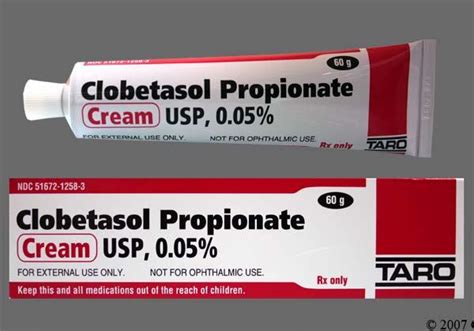Clobetasol topical ointment is a highly potent corticosteroid used to treat various skin conditions, including psoriasis, eczema, and dermatitis. It belongs to the class of superpotent topical corticosteroids, which are known for their strong anti-inflammatory and immunosuppressive properties. The active ingredient, clobetasol propionate, is a synthetic corticosteroid that works by reducing the production of inflammatory chemicals in the body, thereby alleviating symptoms such as redness, swelling, and itching.
Mechanism of Action
Clobetasol topical ointment works by penetrating the skin and interacting with specific receptors, which triggers a cascade of events leading to the reduction of inflammation. The exact mechanism involves the inhibition of phospholipase A2, an enzyme responsible for the production of pro-inflammatory mediators. By blocking this enzyme, clobetasol reduces the synthesis of leukotrienes and prostaglandins, which are key players in the inflammatory response. Additionally, clobetasol suppresses the expression of inflammatory genes, further contributing to its anti-inflammatory effects.
Indications and Usage
Clobetasol topical ointment is indicated for the treatment of various skin conditions, including:
- Psoriasis: a chronic autoimmune disorder characterized by thick, scaly, and inflamed skin patches
- Eczema (atopic dermatitis): a condition marked by dry, itchy, and inflamed skin
- Dermatitis: a general term for skin inflammation, often caused by allergic reactions or irritants
- Lichen planus: an inflammatory condition that affects the skin and mucous membranes
The ointment is typically applied to the affected area 1-2 times a day, depending on the severity of the condition and the patient’s response to treatment. It is essential to follow the doctor’s instructions and use the ointment for the recommended duration to avoid potential side effects and ensure optimal efficacy.
Potential Side Effects
While clobetasol topical ointment is generally well-tolerated, it can cause some side effects, particularly with prolonged or excessive use. Common side effects include:
- Skin thinning (atrophy)
- Redness and irritation
- Itching or burning sensation
- Acne-like lesions
- Allergic contact dermatitis
In rare cases, clobetasol can cause more severe side effects, such as:
- Cushing’s syndrome (a hormonal disorder caused by prolonged exposure to corticosteroids)
- Adrenal suppression (reduced production of natural corticosteroids)
- Osteoporosis (weakened bones)
- Glaucoma (increased eye pressure)
Precautions and Contraindications
Clobetasol topical ointment is not suitable for everyone, particularly those with certain medical conditions or taking specific medications. Precautions and contraindications include:
- Pregnancy and breastfeeding: Clobetasol should be used with caution in pregnant or breastfeeding women, as it may be absorbed into the bloodstream and affect the unborn baby or infant.
- Infection: Clobetasol should not be used on skin infections, such as impetigo, unless advised by a doctor.
- Rosacea: Clobetasol can exacerbate rosacea, a condition characterized by redness and acne-like lesions.
- Allergic reactions: Patients with a history of allergic reactions to corticosteroids or other ingredients in the ointment should avoid using clobetasol.
Interactions with Other Medications
Clobetasol topical ointment may interact with other medications, including:
- Corticosteroids: Using multiple corticosteroids simultaneously can increase the risk of side effects.
- Anti-inflammatory medications: Combining clobetasol with other anti-inflammatory medications may enhance the risk of adverse effects.
- Antibiotics: Clobetasol may reduce the effectiveness of certain antibiotics, such as tetracyclines.
Storage and Handling
Clobetasol topical ointment should be stored at room temperature, away from direct sunlight and moisture. The ointment should be handled with clean hands, and any excess ointment should be wiped off with a clean tissue.
Dosage and Administration
The dosage and administration of clobetasol topical ointment vary depending on the condition being treated and the patient’s response. Typically, a thin layer of ointment is applied to the affected area 1-2 times a day. The ointment should be gently massaged into the skin until it is fully absorbed.
Conclusion
Clobetasol topical ointment is a highly effective treatment for various skin conditions, including psoriasis, eczema, and dermatitis. While it is generally well-tolerated, it can cause side effects, particularly with prolonged or excessive use. Patients should follow the doctor’s instructions and use the ointment for the recommended duration to minimize potential risks and ensure optimal efficacy.
What is clobetasol topical ointment used for?
+Clobetasol topical ointment is used to treat various skin conditions, including psoriasis, eczema, and dermatitis.
How does clobetasol work?
+Clobetasol works by reducing the production of inflammatory chemicals in the body, thereby alleviating symptoms such as redness, swelling, and itching.
What are the potential side effects of clobetasol?
+Potential side effects of clobetasol include skin thinning, redness and irritation, itching or burning sensation, acne-like lesions, and allergic contact dermatitis.
Can clobetasol be used during pregnancy or breastfeeding?
+Clobetasol should be used with caution in pregnant or breastfeeding women, as it may be absorbed into the bloodstream and affect the unborn baby or infant.
How should clobetasol be stored and handled?
+Clobetasol should be stored at room temperature, away from direct sunlight and moisture, and handled with clean hands.
What is the typical dosage and administration of clobetasol?
+The typical dosage and administration of clobetasol vary depending on the condition being treated and the patient’s response, but it is typically applied 1-2 times a day.



